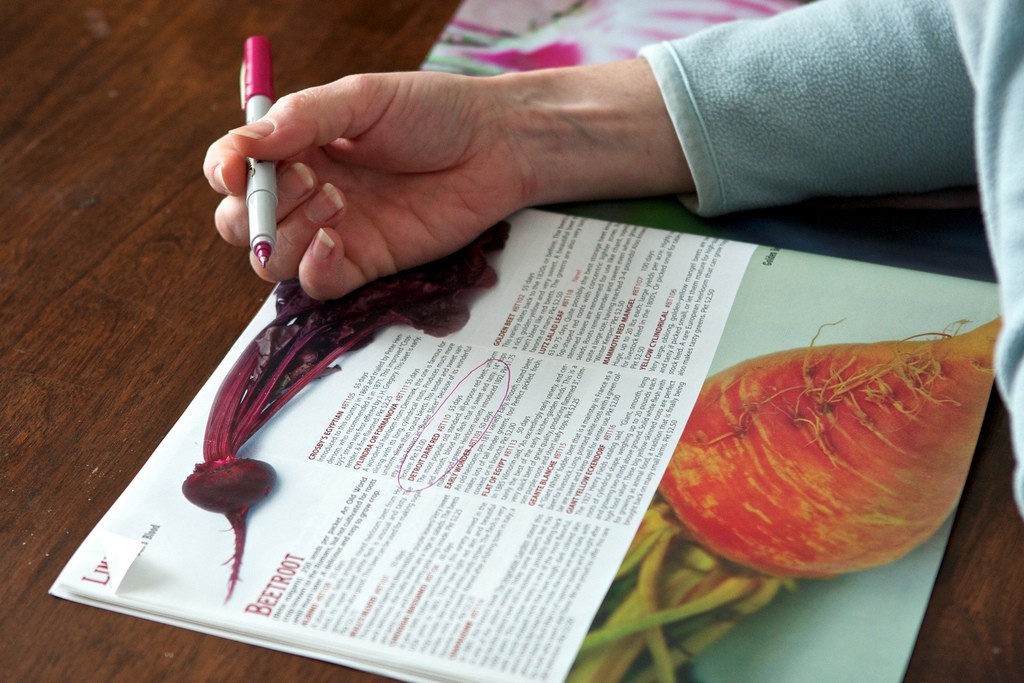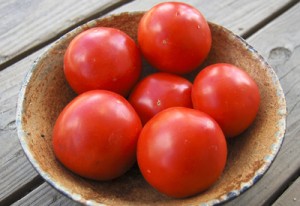Pretty pictures warm a gardener’s heart in winter
Now that winter has finally stumbled onto the stage like some drunken rock star who overslept at the hotel, many of us have noticed that cold still feels, well, cold. Even after a long absence. With holiday parties a dim memory (for some dimmer than others), we are back at it, our noses to the grindstone. Knowing that daylight is still in short supply and ample chilliness lies ahead, it’s normal to start itching for a distraction.

Winter gardening recreation–ordering seeds. Photo: Susy Morris, Creative Commons, some rights reserved
It is a time when some of us give in to the temptation of certain types of publications. You know what I mean. Those glossy, full-color pictures that make our hearts beat faster. Yes, it’s the heartbreaking seduction of seed catalogs!
It isn’t fair, really. We’re on the opposite side of the globe from summer and seed companies go and flaunt giant ripe tomatoes, and flawless yellow, green and red peppers before us. It makes us want to indulge past our budget even though our produce has never been as voluptuous or as brilliant of color as the catalog pictures. This year it will be different, we tell ourselves.
And it could be. Each year brings new vegetable varieties that are superior in certain ways. They may be resistant to viral, fungal, or bacterial diseases, or they may tolerate adverse conditions. So we do have a better chance of success this year.
Every winter, Cornell updates its Selected List of Vegetable Varieties for Gardeners in New York State, available at www.gardening.cornell.edu or at your Cornell Cooperative Extension office. The list includes tried-and-true varieties along with new offerings, and it notes which varieties are resistant to what diseases or good for what conditions.

Yugoslavian finger squash. Photo: Farmanac, Creative Commons, some rights reserved
There’s nothing wrong with buying novelty varieties—it helps keep gardening fun. Do purple carrots and Yugoslavian finger-fruit strike your fancy? Go for it, but get some stodgy varieties with good track records too. The old standby types often translate to more produce for your buck.
Another money-saving tip is to consolidate seed-buying. If a group of people share a half-ounce of carrot seeds, for example, instead of each buying two packets, the price difference is amazing.
Believe it or not, a number of common plant diseases can arrive on the seeds you buy. I once heard a Cornell vegetable expert say that the most important factor in tomato disease prevention was to get disease-free seeds. Second to that was sanitation. I’m pretty sure he meant garden sanitation, not municipal. Such measures can help minimize common diseases that reside in the soil, such as tomato Septoria spot and Alternaria.
Since infected seeds look just as clean as healthy seeds, the only way to be safe is to ensure they’ve been treated, either with a sanitizing solution or by hot water immersion. Evidently seed companies have found the Goldilocks-perfect temperature hot enough to kill disease yet not so much that it kills the living plant embryo inside the seed. (And also is just right for Baby Bear.)

The new Iron Lady tomato provides resistance to three fungal diseases. Photo: High Mowing Organic Seeds/Cornell Chronicle
A few serious diseases like powdery mildew and late blight are wind-borne, and no amount of seed selection or garden sanitation can keep those types of spores off your plants. This is why it’s important to plant at least some disease-resistant varieties.
Along with sexy blue snap beans and black tomatoes, buy a few packets of resistant tomatoes like ‘Iron Lady’ or ‘Defiant.’ Powdery mildew-resistant winter squash include ‘Bugle’ butternut, and ‘Royal Ace’ acorn squashes. Also, buy treated seeds from a reputable source. Order early, though, because many popular disease-resistant varieties sell out fast.
And please try not to drool excessively on those catalogs; someone else might want a look at it after you. Here’s to sweet dreams of warmth and lush gardens for 2016!
Paul Hetzler is a horticulture and natural resources educator with Cornell Cooperative Extension of St. Lawrence County.
Tags: gardening, plant pests, seed catalogs







